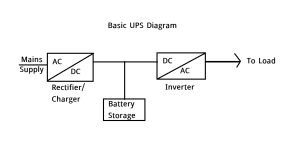UPS is a power electronics device which stands for Uninterruptible Power Supply. We will Discuss about Different type of UPS: Offline UPS, Line Interactive UPS and Online UPS.
To supply an interrupt free power to the load UPS is used. As per bellow basic block Diagram UPS has 3 primary parts:
- Rectifier: It Converts Input AC Power into DC Power to charge the Batteries and to supply DC Power to the Inverter Input.
- Battery Storage: Battery Storage is the string of certain quantity of batteries connected in series or parallel to storage DC Energy.
- Inverter: Inverter Converts DC Power into AC Power to supply controlled AC power to the output Loads.
Internal Block Diagram Of Online UPS:

Categories Of UPS:
- Offline UPS: Offline UPS To Switch on Storage mode Manually when the mains power is shut down or fail. It’s an older technology. now a days these types of UPS are not in used. Switching/ transfer time of Offline UPS is >/=1-2 Seconds.
- Line Interactive UPS: Line Interactive UPS are in Charging mode when mains power supply is present, And the Loads are run with bypass line which feed the Input row power to the loads. If the mains power is failed or not present, then it switches on the inverter to feed the Battery storage power to the loads. Switching /Transfer time of Line Interactive UPS is <4ms.
- Online UPS: Loads are always run with inverter power with Online UPS. So that the charging of Batteries and feeding inverter power to the loads are runs always with online UPS. When mains power is failed, then loads are transferred to the Battery without any delay. So, the Switching/Transfer time of Online UPS are 0(Zero). Now a days Online UPS are with more variety’s protection and features. Quasi square wave, square wave, sine wave, double conversion, transformer based, transformer less, IGBT based rectifier, thyristor-based rectifier, DSP Controlled, PWM Controlled, Modular, Tower, Parallel kit , SNMP Communication, Dry Contacts Communication, STS etc. features are added as per variation of connecting loads.
Related Discussion: Solar Energy/Power
Related
